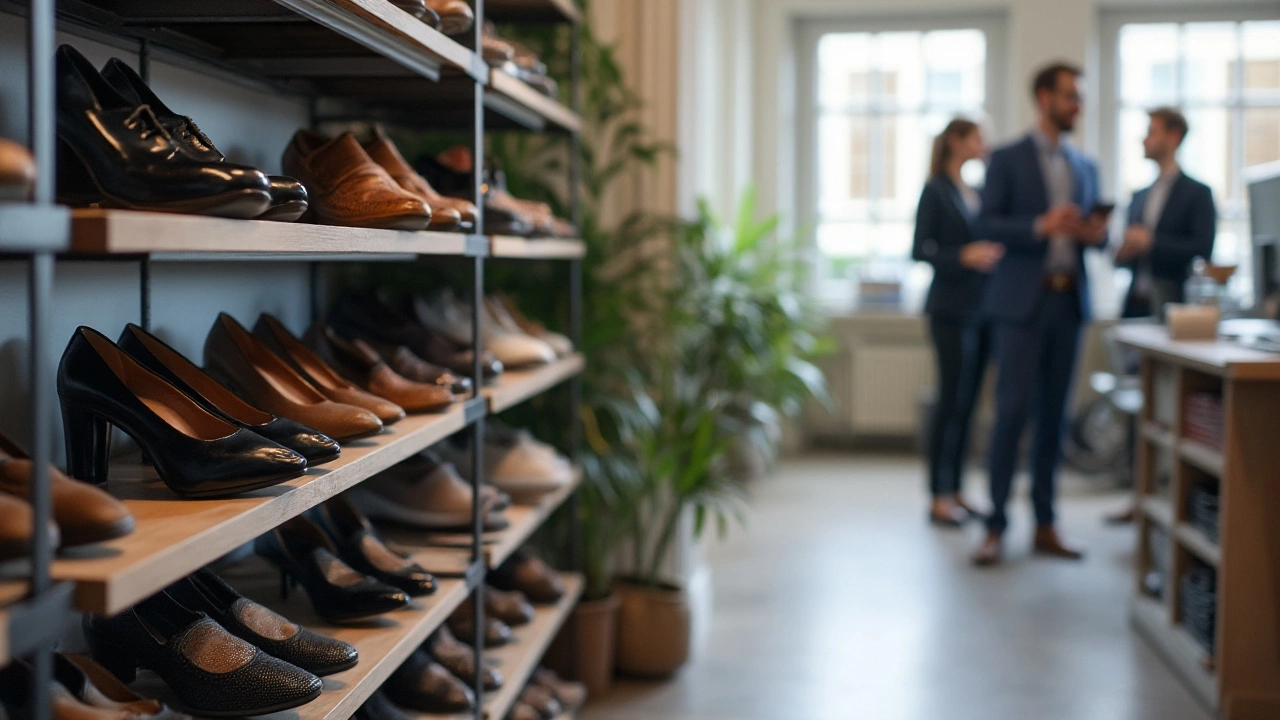Picking the perfect pair of shoes for work involves more than just finding something that matches your outfit. It's about blending comfort, style, and appropriateness, depending on your work environment. While some companies foster a relaxed dress code, others might uphold stricter standards, pushing us to turn our attention towards how our footwear choices impact our professionalism.
The classic debate of heel versus flat, or even sneaker, often arises when one aims to maintain a balance between comfort and meeting workplace expectations. This article guides you through the maze of work shoe etiquette, offering insights not just on what is allowed but what works best for different settings. Read on to discover practical advice and personal stories to help you step confidently in whatever workplace you find yourself.
- Understanding Workplace Dress Codes
- The Role of Comfort in Work Footwear
- Style vs. Functionality: Finding Balance
- Office Environment: Matching Shoes to Settings
- Tips for Selecting the Perfect Pair
Understanding Workplace Dress Codes
In the realm of professional attire, work shoes often play a pivotal role in aligning one’s appearance with company expectations. Recognizing the nuances of dress code policies is crucial to making informed footwear choices. Dress codes serve as a guideline for what an organization deems appropriate, ensuring a harmonious work environment. From business formal to casual, each type of dress code carries its own set of shoe expectations. Business formal, often found in industries like law or finance, might demand classic options such as polished loafers or sleek heels. In contrast, a business casual setting, common in tech companies or creative fields, may welcome dressy sneakers alongside traditional options.
Creating clarity about dress codes begins with understanding their purpose. Not merely a means of control, these codes reflect the brand’s image and culture. As a result, it’s key to interpret the unwritten rules that sometimes accompany formal policy documents. Even within the same company, there might be variations depending on the department. For example, sales teams might adhere to stricter guidelines compared to development teams. To navigate these variations, observe peers and consider consulting HR or a team leader when in doubt.
An insightful observation by fashion expert Tim Gunn emphasizes, "Dress codes are a language. They communicate reliability, trust, and professionalism."
Interpreting this 'language' requires more than reading what's on paper; it's about grasping the ethos of a workplace. The significance of work-specific footwear choices extends beyond aesthetics to encompass elements of safety and comfort. In industries requiring protective gear, safety shoes conforming to specific standards might be mandated, adding another layer to dress code understanding.
Equipping oneself with the right information before stepping into the realm of workplace attire is vital. This often involves paying close attention to the industry standards specific to one’s profession. Arriving at a proper balance is as much about discerning what is fitting as it is about expressing individuality within accepted norms. Ultimately, reading the cues and aligning one’s shoe choices with the corporate culture can lead to enhanced confidence and acceptance in the professional sphere.
The Role of Comfort in Work Footwear
When it comes to selecting work shoes, comfort is often the unsung hero that dictates our daily performance and long-term well-being. A poorly chosen pair of shoes can disrupt your concentration, decrease your productivity, and even lead to chronic health issues. Whether you stand all day, walk frequently around the office, or mostly sit at a desk, the level of comfort your shoes provide can significantly impact your work experience. Understanding the anatomy of a good shoe involves acknowledgment of factors like the right arch support, cushion, and fit. The Association of American Podiatric Medical Association points out that nearly 77% of adults have experienced foot pain due to choosing poorly fitting shoes at some point in their lives. Such discomfort isn’t just a fleeting nuisance; it can cascade into knee, hip, and back pain if not addressed.
For those spending hours on their feet, such as healthcare professionals or retail workers, choosing shoes with additional support and shock absorption becomes crucial. A study suggests that proper ergonomic shoes reduce muscle fatigue by 20% and enhance energy efficiency. For the office worker who is predominantly seated, a cushioned insole or a slightly raised heel can prevent achiness after transitional movements between sitting and standing. This might be particularly pertinent for individuals working in creative fields where they might shift between different workstations.
Hidden beneath the guise of personal style, comfort should take precedence, and thankfully, modern footwear designers recognize this growing demand. The market now flourishes with elegant options that don’t compromise on comfort.
Comfort in footwear is not a luxury; it’s a practical necessity when considering long-term health and productivity, noted Dr. Emily Splichal, a prominent podiatrist.Prioritizing comfort by investing in shoes that reduce strain not only benefits you physically but contributes to a more serene mental state, allowing you to focus on the tasks at hand rather than discomfort.
So, how do you marry comfort with professionalism? It starts by acknowledging the shoes that support not just your body, but your workplace duties. Office footwear doesn't need to sacrifice aesthetics for utility. Begin with identifying shoe brands that are known for their ergonomic designs. Opt for leather or breathable fabrics, which offer durability without compromising circulation. If your workplace permits, look into brands offering sneakers that utilize memory foam or air pocket soles, striking that coveted balance between style and support.

Style vs. Functionality: Finding Balance
When it comes to selecting work shoes, many individuals find themselves caught between wanting to express personal style and needing to choose shoes that complement their professional duties and environments. This balancing act is not just about aesthetics but also hinges on physical comfort during those long hours at a desk or moving through a bustling office. Recent studies show that the average professional spends over eight hours a day in their shoes, which suggests that poor shoe choices can lead to discomfort and even health issues such as foot pain or posture problems.
Among the vast variety of shoes available, each type serves a different purpose. For instance, high heels might be stylish and can often elevate an outfit, but they aren’t always the best choice if you’re on your feet all day. Conversely, sneakers offer unparalleled comfort but might not always align with the dress code of corporate settings. It’s important to evaluate your daily activities when making your choice. A study by the American Podiatric Medical Association found that 71% of people complain about foot pain due to improper shoe selection, highlighting the necessity of functionality.
«A well-designed shoe will possess the perfect balance between fit, form, and function», said Kate Middleton, the renowned style editor at Footwear Magazine, in a recent interview. The concept of combining fashion with functionality is key, and choosing leather loafers or stylish flats could be the answer. Unlike heels, these shoes can easily match many office attires while offering the ability to handle both a desk job and impromptu meetings.
For those working in creative industries or startups with a more relaxed office footwear policy, introducing elements such as bold colors or unique patterns through your shoes can become an extension of your personal brand and creativity. Some companies actively encourage this expression through dress to nurture an unorthodox atmosphere, which is part of their appeal to younger generations.
Let's break down how you can ensure that your workplace shoes provide both style and functionality:
- Assess your daily tasks: Acknowledge whether your role involves long periods of standing or frequent commuting. This can majorly influence your shoe choice.
- Material matters: Leather and canvas have different daywear suitability and durability, so choose materials that resonate with your typical work day.
- Invest in quality: Sometimes paying a little extra upfront may result in shoes that last longer and maintain their appearance, making them cost-effective in the long run.
- Check for arch support and cushioning: Especially important for those involved in dynamic jobs.
- Keep a few versatile pairs: A mix of traditional and modern styles can prepare you for unique workplace demands.
The key to mastering the balance between style and functionality in professional shoes lies in knowing your company's dress code policies juxtaposed with personal comfort needs. This knowledge equips professionals to make informed choices that do not sacrifice their well-being for fashion nor their unique style for rigid conformity.
Office Environment: Matching Shoes to Settings
Navigating the office footwear landscape can seem daunting, especially when each office environment brings its own set of dress code nuances. Understanding these expectations is vital in ensuring your shoe choices fit seamlessly into your workplace wardrobe. For instance, a corporate setting will typically lean towards more formal shoes such as classic pumps or oxfords, emphasizing polished leather and sleek designs. On the other hand, more creative industries might welcome trendy loafers or even fashionable sneakers, allowing for more personality to shine through one's attire.
Consider a traditional corporate office setting. Here, professional shoes are not just a suggestion—they're often a requirement. Leather is typically the material of choice; it conveys a sense of sophistication and respect. Shoes should generally be closed-toe, whether you're opting for a heel or flat, to maintain a conservative and polished appearance. It's said that in many financial districts, the shoe polish level and style can impact first impressions almost as much as attire itself, subtly communicating attention to detail and professionalism. This approach highlights why ensuring your shoes are in pristine condition is as crucial as the style you choose.
In contrast, tech companies and creative industries embrace a more laid-back approach. The focus is often on comfort without compromising style. In these settings, employees might find themselves free to sport office footwear that includes designer sneakers or quirky shoes with character, which can become conversation starters. According to a renowned fashion editor, Creative Director Jessica Singh once quipped that 'the right shoe can be the bridge between professional and authentic.' By choosing shoes that align with both your character and the relaxed dress code, you remain professional while adding a personal touch.
Let's not forget workplaces with uniforms or safety regulations, such as hospitals or construction sites. Here, the requirements prioritize safety and practicality above everything else. Shoes in these environments often need features like slip-resistant soles or specific toe protection. For instance, in healthcare, the shift towards breathable, supportive clogs is expanding due to their balance of comfort and compliance with work shoes standards. This trend is based on feedback from workers who spend long hours on their feet, reflecting a shift in footwear design priorities.
Table 1 demonstrates the distribution of shoe types across different office settings based on a 2023 survey:
| Setting | Preferred Shoe Type | Percentage |
|---|---|---|
| Corporate | Formal Leather Shoes | 62% |
| Tech/Creative | Casual Sneakers | 47% |
| Uniformed | Practical/Supportive | 91% |
Decoding what each work environment expects can spare you from awkward mishaps. A smart strategy is always observing those around you, especially in similar roles, and taking cues from them. Interplay between current trends and workplace traditions plays a vital role too. Striking this balance not only positions you as an astute professional but also allows you to embrace an authentic work shoes choice that resonates with your style while supporting your work demands. Overall, understanding and adapting your footwear to suit different office environments can enhance your daily work experience by marrying style and necessity.

Tips for Selecting the Perfect Pair
When it comes to selecting the perfect pair of work shoes, it's crucial to think beyond aesthetics. The choice of work shoes extends to considerations like comfort, workplace culture, and even climate, making your footwear decisions more integral to your daily life than one might initially surmise. A key factor to examine is comfort—nobody wants to be distracted by aching feet while trying to stay productive. As the early 20th-century author Anita Loos humorously suggested, "I've always found that my fan-shaped delicate shoes and my acute discomfort always got top billing in the theatre of my daily grind." Comfort does not merely pertain to cushioning, but also proper support which can vary significantly from person to person. A trip to a specialized shoe store can aid in understanding one's foot arch type, providing a mix of science and style to your work footwear.
Another cornerstone of office footwear choice is understanding your workplace dress code. Every office has its culture and preferred modes of dress, and shoes often subtly reflect this ethos. In progressive companies, chic sneakers might be perfectly acceptable, while more traditional environments could demand polished leather shoes or delicate heels. Knowing the distinction can help navigate the terrain of fitting in with colleagues and staying on the good side of HR policies. Customarily, offices operating on a casual dress code range from those allowing sneakers and chic flats to dress sandals. Here, style meets versatility, as these settings allow a broader palette to work with while ensuring you don't skirt your professional obligations.
Style undoubtedly plays an intriguing role in the quest for the right shoes, yet striking a balance between elegance and utility is essential. Though stilettos might elevate a business ensemble, the practicality of maneuvering a bustling work environment in them can be questionable. Opt for heels with more reliable designs like chunkier or kitten styles, offering both a touch of class and functional prowess. Consider reserve pairs stored at the office; typically loafers or flats, which can safeguard against unexpected incidents or daily variation of dress code.
Understanding the specific climate and terrain of your work environment can lead to more informed choices as well. If you find yourself traveling frequently or on your feet by occupational demand, weighing more lightweight and durable professional shoes becomes important. Waterproofing and non-slip soles provide practical benefits often overlooked. Similarly, considering seasonal changes and environments can influence whether breathable mesh or classic leather fits your needs. A study conducted in 2022 revealed that employees who selected adaptable footwear noticed a 15% increase in focus throughout their workdays, directly linking adaptation with improved workplace efficacy.
In conclusion, choosing the right work shoes requires a multi-faceted approach, where each aspect vies for priority based on individual needs and expectations. Making well-rounded decisions centered on comfort, company culture, style, and environmental adaptability results in relieving unnecessary stress and aligning professional image seamlessly. Dive into this footwear selection journey with awareness and creativity, forging between personal comfort and the broader canvas of your professional identity. Whether you're leaning towards classic loafers, refined heels, or staple sneakers, each step you take will be fortified not just by soles but by calculated, thoughtful choices.

